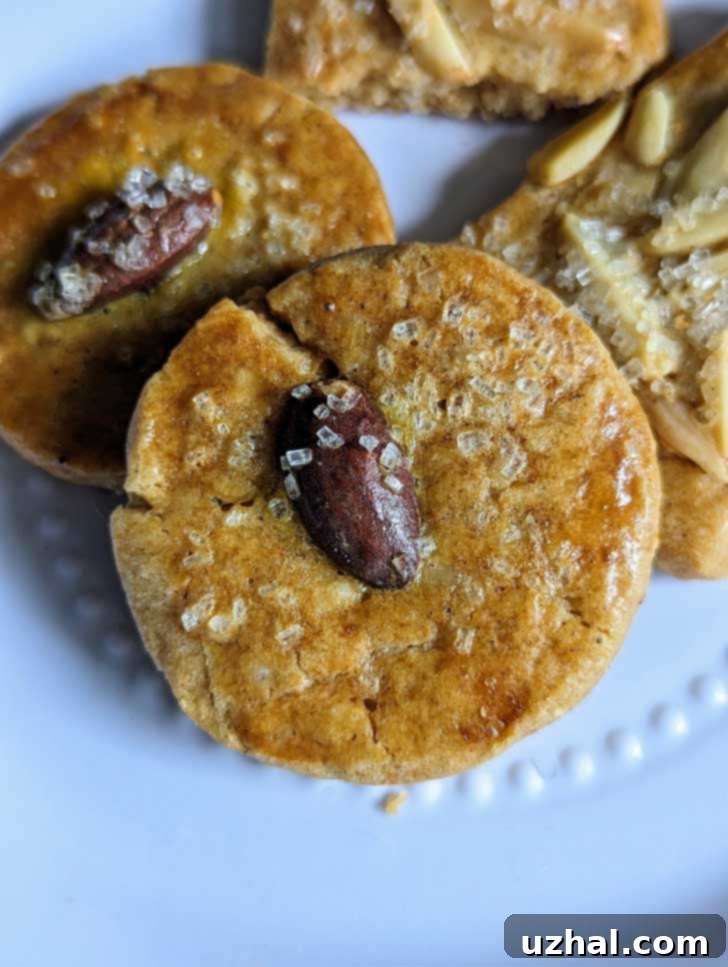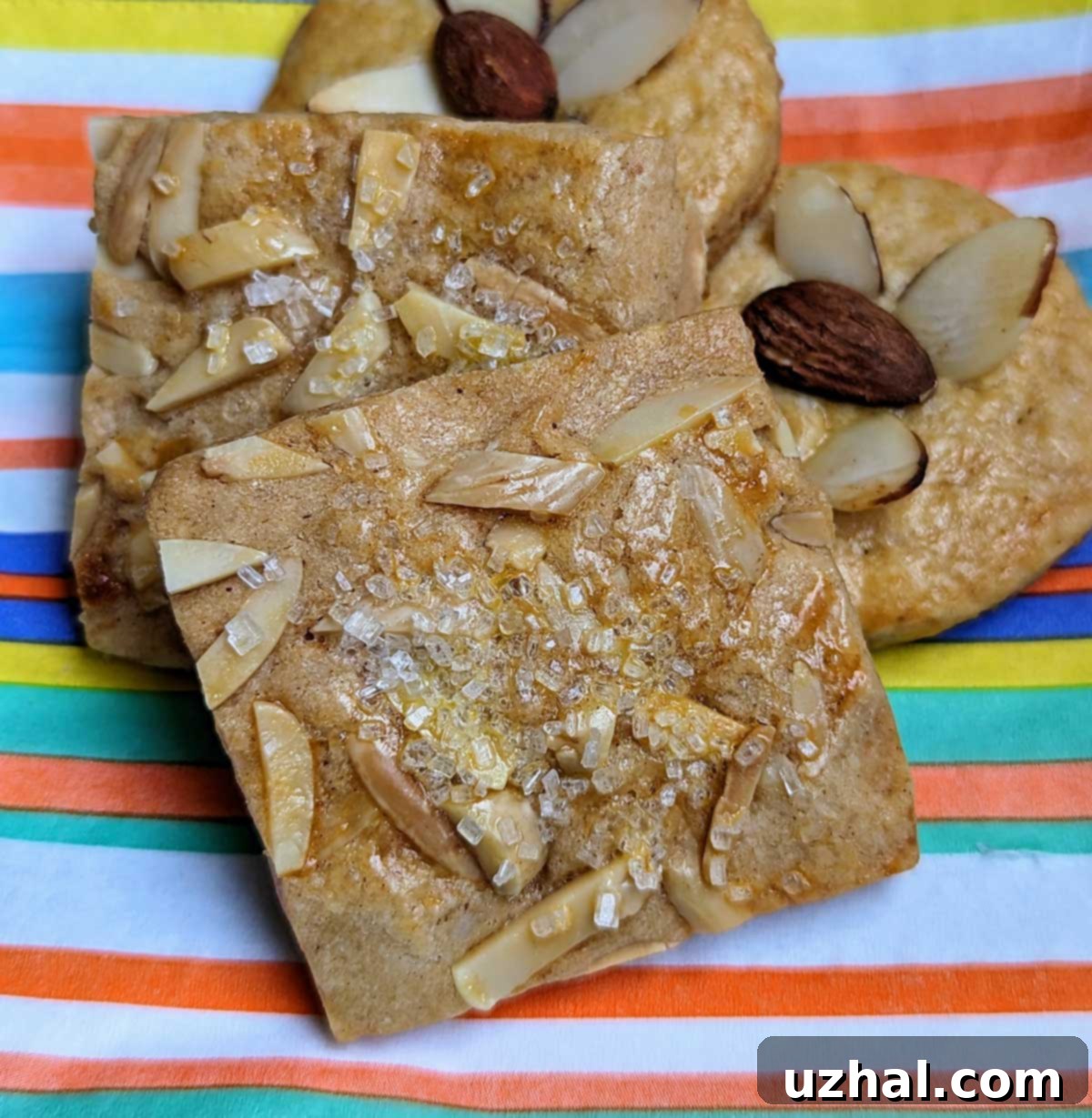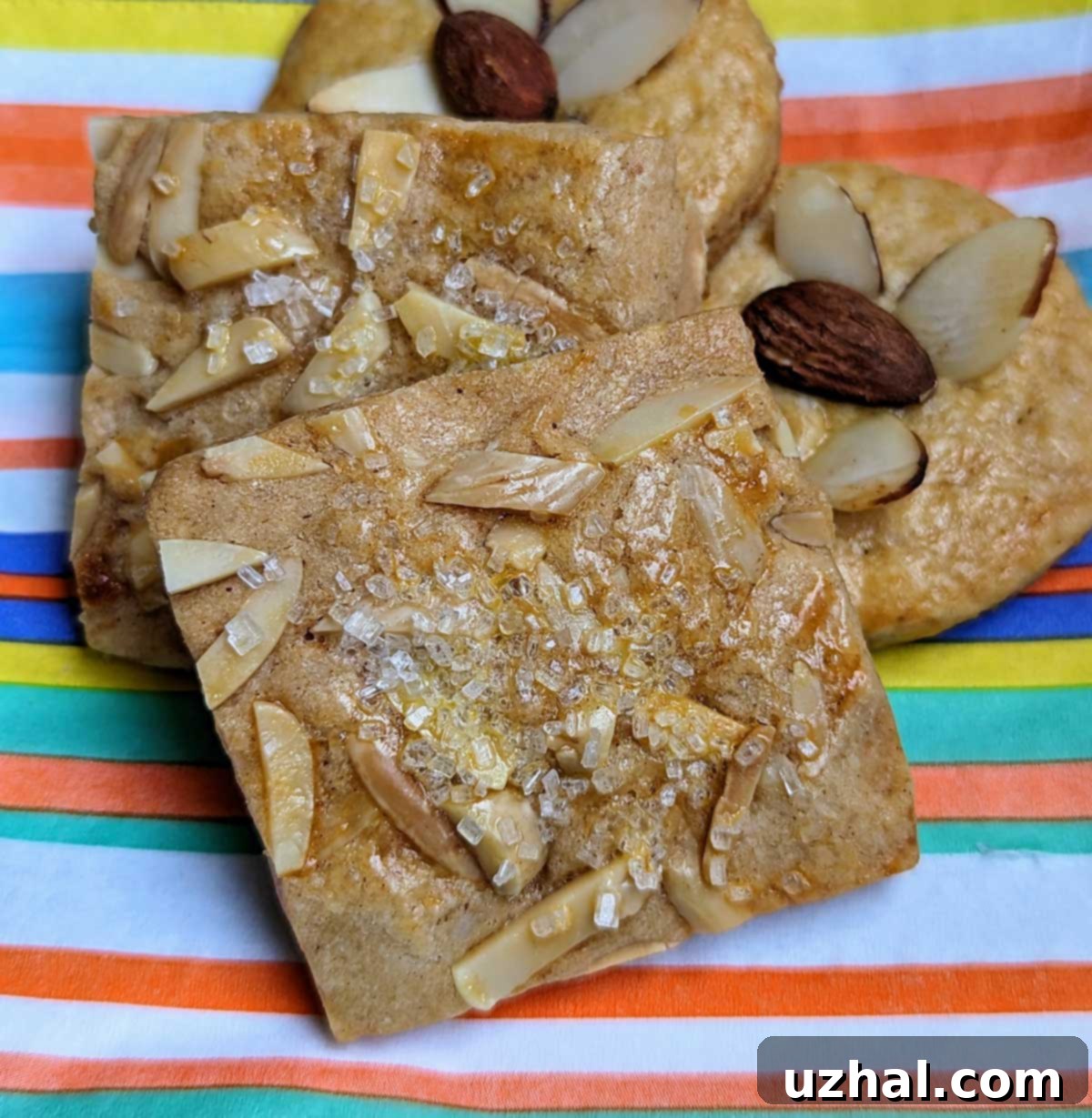Mastering Authentic Chinese Almond Cookies: A Guide to Crispy, Flavorful Homemade Treats
There’s a unique joy in biting into a perfectly crafted Chinese Almond Cookie – that distinct, intense almond flavor coupled with an irresistibly light and crunchy texture. For many, these iconic treats evoke nostalgic memories of bustling Chinese restaurants or special holiday gatherings. While the experience of enjoying them fresh from a restaurant can be unparalleled, replicating that magic at home is a truly rewarding endeavor. This quest for the ideal homemade version, combined with a persistent reader request for a recipe akin to the beloved Trader Joe’s Almond Windmills, led me back to an esteemed old recipe by Helen Witty.
Years ago, I dabbled with this recipe, but regrettably, detailed notes were scarce. Now, after revisiting and refining, I’m thrilled to present these exquisite almond cookies, meticulously tested and perfected in various forms, offering both classic authenticity and delightful variations for every home baker. The charm of Chinese Almond Cookies lies not only in their delightful taste and texture but also in their relative simplicity, making them an excellent project for bakers of all skill levels. They are a staple during Chinese New Year celebrations and are cherished year-round for their delightful snap and aromatic finish. This recipe aims to capture the essence of what makes these cookies so special: a pronounced almond character derived from high-quality almond extract and the nuanced texture that comes from careful ingredient selection. Join me as we explore the crucial elements that contribute to their signature crunch and profound flavor, ensuring your homemade batch rivals any bakery creation.

The Foundation of Texture: Lard, Shortening, or Butter?
One of the most pivotal decisions in crafting the perfect Chinese Almond Cookie, or indeed many traditional baked goods, revolves around the choice of fat. The original, truly authentic Chinese Almond Cookies recipe often calls for lard. Lard, rendered pork fat, is celebrated in baking for its unique properties: a relatively high melting point and a specific crystalline structure that contributes to an exceptionally tender and flaky texture in pastries, and a distinct crispness in cookies. Its natural flavor, when refined, is often quite subtle, allowing other flavors, like almond, to shine through, providing that authentic background to the pronounced almond extract.
In my recent baking experiments, a lack of readily available lard prompted me to explore alternatives. My initial attempt utilized vegetable shortening, a popular substitute due to its similar high fat content and solid state at room temperature. The results were remarkably successful in terms of texture: the cookies emerged from the oven wonderfully crisp and crunchy, exactly what one desires in an almond cookie. This specific shortening delivered an impressive structural quality, holding its shape beautifully and providing that satisfying snap with every bite. The uniformity and crispness achieved with shortening made for an excellent cookie base.
However, while the texture was ideal, the flavor profile of that particular brand of shortening left something to be desired for my palate. It introduced a subtle undertone that, for me, slightly detracted from the pure almond essence I was aiming for. This led to a subsequent batch, where I opted for unsalted butter. Butter, with its rich dairy flavor and lower melting point compared to shortening or lard, behaves differently in a cookie dough. The water content in butter also contributes to a different gluten development, which can affect the final texture.
While the butter cookies maintained their shape admirably and offered a delightful richness, they notably lacked the pronounced crispness and crunch that the shortening-based cookies achieved. The butter version yielded a slightly softer, more tender cookie, characteristic of many Western-style shortbreads, which, while delicious, strayed a bit from the traditional Chinese almond cookie texture. This distinction highlights the significant impact of fat choice on the final sensory experience of a cookie, proving that even a seemingly small alteration can lead to a profoundly different result.
Ultimately, the choice among lard, shortening, or butter comes down to a balance between desired texture and flavor. If an authentic, exceptionally crisp and light texture is paramount, and you appreciate its neutral or subtly savory notes, lard is undeniably the traditional and often superior choice. If lard isn’t accessible, a high-quality, flavor-neutral vegetable shortening can provide a fantastic crunch. For those who prioritize a richer, more buttery flavor, even at the expense of some crispness, unsalted butter is a delicious alternative. Each fat offers a unique contribution, inviting you to experiment and discover your personal preference for these delightful almond treats, making each batch a personalized baking adventure.

Shaping and Customization: A Global Almond Journey
Beyond the foundational ingredients, the visual presentation and subtle flavor enhancements can elevate these almond cookies from simply delicious to truly exceptional. While traditional Chinese almond cookies are often round, adorned with a single almond in the center, my recent experimentation led to diverse shapes. As you can observe in the accompanying images, some cookies were precisely cut using classic round cutters, maintaining a familiar aesthetic. However, I also ventured into shaping some of the dough into elegant squares. This simple alteration unexpectedly lent them a resemblance to certain Scandinavian-style cookies, particularly those often found in assortments of crisp butter cookies. This discovery highlights the versatility of the dough and the delightful intersection of various baking traditions, proving that a little creativity in presentation can transform the perception of a classic treat.
The beauty of this recipe lies in its adaptability. Whether you opt for the classic round shape, experiment with squares, or even use more intricate cookie cutters for special occasions, the core almond flavor remains the star. This flexibility extends to the choice of fat, as discussed earlier, allowing you to tailor the cookie’s texture and richness to your exact liking. The journey of making these cookies is as much about personal preference as it is about following a recipe; it’s an invitation to make them uniquely yours. Feel free to explore different cookie cutter shapes to match the occasion or simply to add variety to your cookie jar.
To further enhance the experience, consider the finishing touches. A sprinkle of sparkling sugar on top, while entirely optional, serves multiple purposes. It adds a delicate hint of extra sweetness, which is particularly welcome since the base cookie itself is not overly sweet, allowing the almond flavor to truly dominate. More importantly, it provides an additional textural dimension – a delightful, subtle crunch that complements the cookie’s inherent crispness, creating a multi-layered sensory experience. Feel free to be generous with the sparkling sugar; its crystalline texture catches the light beautifully and promises a satisfying bite, making each cookie not just a treat for the palate but also for the eyes.
For those eager to explore beyond pure almond, these cookies offer a fantastic canvas for additional flavor infusions. If you happen to have a Speculoos spice mix on hand, or even a readily available pumpkin pie spice blend, try incorporating a teaspoon into the dry ingredients. These aromatic spices introduce warm, complex notes of cinnamon, nutmeg, ginger, and cloves, which harmonize wonderfully with the almond, adding a depth that can be surprisingly delightful. This simple addition can transform the cookie, adding depth and a comforting aroma, making them perfect for autumn gatherings or a cozy afternoon treat. Other possibilities include a touch of finely grated orange or lemon zest for brightness, a hint of vanilla bean paste for added richness, or even a dusting of cocoa powder for a subtle chocolate-almond twist, allowing for endless creative permutations.
The Helen Witty Difference: Why This Recipe Is A Keeper
This particular recipe, originating from the culinary wisdom of Helen Witty, stands out for several reasons. It strikes an admirable balance between traditional methods and achievable home baking. Witty’s approach focuses on simplicity without compromising on flavor or texture. The ingredient ratios are finely tuned to produce a cookie that is robust enough to handle various shaping techniques yet delicate enough to melt in your mouth. The specified baking temperature and time are crucial, as Chinese almond cookies benefit from a slower, lower bake to achieve their characteristic uniform pale color and crispness without browning too quickly, which can lead to a less desirable texture.
What makes this recipe especially reliable is its emphasis on key steps, such as chilling the dough. This isn’t just an optional pause; it’s a vital stage that allows the fats to solidify, preventing excessive spreading in the oven and ensuring your cookies retain their intricate shapes and desirable thickness. The careful integration of both granulated and brown sugar also contributes to the cookie’s unique profile – granulated sugar promotes crispness, while brown sugar adds a subtle chewiness and depth of flavor, creating a more complex end product. By following Witty’s clear instructions, even novice bakers can confidently achieve impressive results, yielding a batch of cookies that are consistently delicious and visually appealing, batch after batch.
- Chinese New Year Treats
- Light Crisp Sugar Cookies
- Leaf Lard Ginger Cookies
- Crispy Baked Gau 15 Years Later
- Almond Filling Almond Crescents
Recipe

Chinese Almond Cookies
Anna
Pin Recipe
Ingredients
- 1 cup lard, Crisco or unsalted butter (190 grams shortening or 214 grams butter)
- ½ cup dark brown sugar (110 grams)
- ¼ cup granulated sugar (50 grams)
- 2 large eggs, cracked in a separate bowl**
- 1 tablespoon almond extract
- ½ cup finely chopped toasted almonds
- 2 ½ cups all-purpose flour (340 grams)
- 1 ½ teaspoons baking powder
- ¾ teaspoon salt
- almonds and coarse sugar for garnish
Instructions
-
In a mixing bowl, using a wooden spoon or electric mixer, beat lard or whichever fat your are using until creamy. Beat in both sugars.
-
Whisk together the eggs in a separate bowl and measure out 2 tablespoons. Set aside to be used for an egg wash. Stir remaining eggs. almonds and almond extract into the sugar mixture.
-
Stir together flour, baking powder and salt, then mix into batter to form a soft dough.
-
Divide dough in half and press each half into a slab about ⅓ of an inch thick. Chill the slabs while you preheat the oven or until you are ready to bake.
-
Preheat oven to 275 degrees F.
-
When ready to bake, punch out rounds with a 1 ½ to 2 inch cookie cutter. Brush tops of cookie dough rounds lightly with the reserved 2 tablespoons of egg, and place an almond in the center. For a little extra crunch, you can sprinkle the cookies with coarse sugar.
-
Bake time for the cookies should be about 35 minutes.
Notes
Conclusion: Your Journey to Perfect Almond Cookies
Crafting homemade Chinese Almond Cookies is more than just following a recipe; it’s an exploration of flavor, texture, and personal preference. From selecting the ideal fat to choosing between traditional rounds or charming squares, every step offers an opportunity to create a truly bespoke treat. Whether you’re seeking the authentic crispness of lard-based cookies, the reliable crunch of shortening, or the rich tenderness of butter, this guide provides the foundation for delicious success.
The pronounced almond flavor, the delightful snap, and the subtle sweetness of these cookies make them a universally loved dessert. They are perfect for sharing during festive occasions, enjoying with a cup of tea, or simply indulging in a moment of sweet bliss. We encourage you to try Helen Witty’s time-tested recipe, experiment with the suggested variations, and make these Chinese Almond Cookies your own. Share your culinary creations and tell us which fat and customization options became your favorite!
